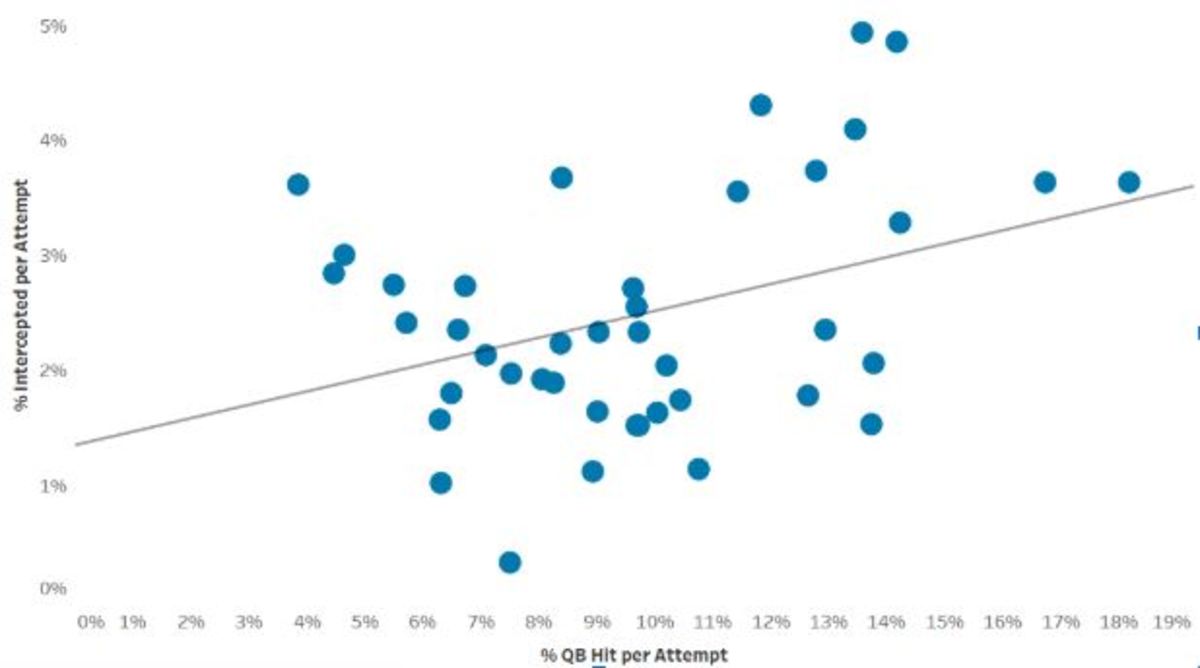How third-downs will make or break Broncos' playoff chances in 2019

The importance of third-down conversions in the NFL cannot be understated. Both the offense and defense must do their part on the 'money down'.
But do fans know just how important the third down is to winning?
To add context to how important third down is, 11-of-12 playoff teams in 2018 had a positive ratio of third-down conversions to third-down stops, while their offenses converted at least 41% of their third downs.
Only three of the 20 teams that missed the playoffs met these criteria. This means that converting and stopping third downs is very important to reaching the postseason.
The sole team that qualified for the playoffs and did not meet the third-down criteria, the Houston Texans, had a turnover margin of +13. Of the three teams that did not qualify for the playoffs, but met the criteria (Pittsburgh Steelers, Tampa Bay Buccaneers, and Carolina Panthers), two had highly negative turnover margins and one was near break-even. Turnovers may explain why the criteria did not hold true.
If the Broncos want to return to the playoffs this season, third down is the key. This article will quickly explore why the Broncos' new offense will be better at converting third downs compared to last season and will do a deep dive into the analytics of stopping the opposing team by focusing on each quarterback Denver will face.
Offense
First, the offense. Last season the Broncos were 28th in the NFL on third-down conversions with a paltry 33% success rate. Most of the time blame goes to the quarterback for everything and in this case it is correct to blame Case Keenum. When the Broncos ran the ball, they converted 56% of their first downs. When they passed, a downright awful 28%. Keenum threw every third-down pass last year and was atrocious at converting to a first down.
John Elway smartly replaced him with Joe Flacco. Flacco did not have a terrific year last season, but he had a better success rate on third down than Keenum by 11 percentage points. Flacco's 39% doesn’t sound great on the surface, but it is as good as Philip Rivers and better than Tom Brady and Aaron Rodgers.
If the Broncos can maintain the same success with the run and Flacco keeps his 39% conversion rate with the pass, the offense should improve their third-down conversion rate to above 40%. If they hit the 41% mark, they have met the first criteria of postseason teams.
Defense
Now the defense. The Broncos face a tough schedule with some formidable quarterbacks. Patrick Mahomes and Rivers in the AFC West and Aaron Rodgers, Andrew Luck, and Baker Mayfield are on the docket as well. This does not bode well for stopping opposing teams on third down.
Many NFL coaches talk about pressure vs. sacks and this is exactly what I am going to illustrate. Some say pressure is better because it leads to interceptions. Others prefer sacks because it is a guarantee that the third-down will not be converted. There is a slight correlation of interceptions to 'QB hits' per pass attempt as the scatterplot below illustrates.

However, it doesn’t have to be one or the other. The analytics show that each quarterback can be attacked differently for maximum effect. Let’s examine each quarterback on the Broncos’ schedule.
Derek Carr, Oakland: The Raiders are the first game of the season. When Carr gets a pass off without absorbing a 'QB hit' he has a third-down conversion rate of 43.1% and an interception rate per attempt of 1.4%.
When Carr gets 'hit' (excluding sacks) his third-down conversion rate drops to 25.0% and is interception rate increases to 8.3%. His drop in conversion rate is significant, but not nearly as significant as his interception rate increase. That is almost a 500% increase! Getting pressure on Carr is key and could change the game with a turnover.
Mitchell Trubisky, Chicago: He is the opposite of Carr. His third-down conversion rate decreases from 45.5% to 40.0% from no 'hit' to absorbing a 'hit' and he did not throw an interception while taking a 'hit' in 2018.
That is good production with a defender bearing down. If the defensive coordinator wants to apply pressure, the defense better get to Trubisky and sack him. The better strategy may be to confuse him with a coverage scheme.
Aaron Rodgers, Green Bay: The Broncos visit the ackers. Rodgers is another QB like Trubisky, in that his third-down conversion rate decrease to only 37.5% from 40.0% and he did not throw an interception when he took a 'hit' last season.
One can look no further than the Broncos’ utter domination of the Packers in the regular season of 2015. The defensive changed their scheme specifically for Rodgers and held him to a paltry 77 yards passing.
Nick Foles, Jacksonville: The Jaguars are next. Foles is in the category of Rodgers and Trubisky although his sample size of throwing while getting 'hit' in 2018 is small. His third-down percentage actually increases when 'hit' but he was only hit three times on third down passes. Take it with a grain of salt.
Philip Rivers, L.A. Chargers: The following week is the Broncos second game against a division opponent. They know Rivers well, but do they know he is night and day when it comes to getting 'hit' versus not? Rivers has a solid 42.9% conversion rate when not under duress, but when he gets 'hit' it declines to 26.3%. His interception rate jumps from 1.7% to 8.0%. This is not as bad as Carr, but almost. Getting in his face is imperative.
Marcus Mariota, Tennessee: Mariota endures a lot of criticism about his quarterback play, but he takes a hit and still produces. His third-down conversion rate stays nearly the same (46.7% to 42.9%). He does tend to throw an interception. His rate increase from 2.2% to 5.3%.
Pat Mahomes, Kansas City: Next up, every national media member’s golden boy. There is no doubt he had a terrific year throwing the ball in 2018. However, when he gets 'hit' he is a different quarterback. His third-down conversion rate was a very good 56.4% and his interception rate was 1.4% while not getting contacted.
When he takes a 'hit', his effectiveness plummets. His third-down conversion rate drops to 31.8% and his interception rate balloons to 6.3%. The Broncos faced him twice last year and in the first meeting, the defense hit him on 20% of his passing attempts.
If not for Vance Joseph using clichés as a coaching strategy and Keenum overthrowing a wide-open Demaryius Thomas, the Broncos would have won that game. In the next meeting, the defense did not do as well and even though the score was close, the game was not nearly as 'in-hand' as the first meeting. This season, getting to Mahomes is priority number one. (See chart below for the Broncos games last season. Chiefs games are in red.)

Andrew Luck, Indianapolis: Under normal circumstances, he converts on third down 49.7% with and interception rate of 2.2%. When getting hit it doesn’t change much. His conversion rate drops to 47.4% and his interception rate increases to 3.4%. A few seasons ago, Luck lost his spleen against the Broncos, but still won the game. Scheme a good defense or get him to the ground with a sack on third down in order to stop him.
Baker Mayfield, Cleveland: Being a rookie in 2018 may have something to do with his performance difference. He needs his offensive line to protect him because his third-down percentage when not 'hit' is a respectable 40.0%, but drops like a rock to 25% when taking a 'hit' His interception rate increases from 2.6% to a whopping 9.1%.
Kirk Cousins, Minnesota: While not under duress, he converts 43.3% of his third downs and has an interception rate of 1.8%. He did not throw an interception while getting 'hit', but his third-down conversion percent dropped to 17.6% in 2018. Needless to say, on third down apply the pressure.
Josh Allen, Buffalo: He is not a third-down conversion machine, to say the least. Without getting 'hit' he converted 34.2% third downs and when getting hit it drops to 14.3%. His interception rate balloons from 2.5% to 12.2%. That interception rate while getting 'hit' is the worst of any quarterback the Broncos will face this season. As a rookie, he did not perform well under pressure.
Deshaun Watson: He is the worst quarterback at converting third downs when getting 'hit' the Broncos will face this season. His third-down conversion rate goes from 44.5% to 13.6%! A massive decrease. His interception rate increases to 6.3% from 1.1%. The Broncos defense needs to harass him all day long, but keep a spy on him because he is dangerous with his legs. When he scrambles he converts 42.9% of his third downs.
Matthew Stafford, Detroit: He is consistent with or without a 'QB hit'. He converts 38.6% of his third downs when he doesn’t get 'hit' and his interception rate is 1.9%. With a 'hit' he converts 40.0% of his third downs and his interception rate only increases to 2.4%. The good news, he was sacked 40 times or 7% of his pass attempts last season. Von Miller and Bradley Chubb should have a productive day.

Bottom line
Based on this analysis, if the Broncos can attack each quarterback appropriately, their chances of stopping a third-down attempt and/or creating a turnover increases.
The defense can improve on the 38.9% conversion rate they allowed last season. The team would meet the postseason criteria for third downs.
Follow Thomas on Twitter @ThomasHallNFL.
